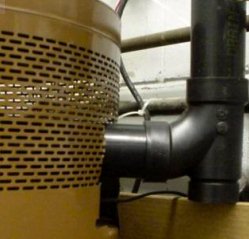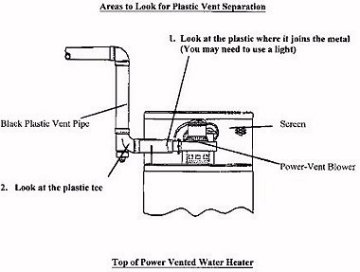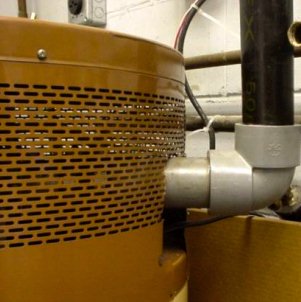
Fuel Safety Bulletin 2000-05a
Issued: December 6, 2000Do You Have this type of Rheem Power Vented Water Heater?
Read on for important safety information from the Fuel Safety Division:
What's the problem?
Fuel Safety has been informed by Rheem Canada Ltd., manufacturer of a power vented water heater, that they have identified a potential stress point at the plastic power-vent blower connection on specific models of Rheem's PV40 and PV50 propane power vented water heaters manufactured between 1992 and 1996.
The vent system is the series of connected pipes (plastic or metal) that lead from your water heater to an outside wall. This piping allows the products of gas combustion to be exhausted to the outside.
The affected pipe is a black plastic pipe that comes out of the screen portion of the water heater near the top. In a small percentage of cases the vent system has become separated at the power-vent outlet or at some point along the vent system.
Step #1
How to check and see if you have this type of Rheem Power Vented Water Heater:
First of all, does it look like this picture?

Rheem PV50 Power Vented Water Heater
Your water heater will have a name plate on the front that will specify the name of the manufacturer. If you cannot find the plate, the Rheem heater can best be identified by the brown colour and screened enclosure of the blower. In the same location that you find the manufacturer's name plate, you will find the serial number. The 1st four digits of the serial number indicate the month and year of manufacture (e.g. 0395-March 1995).
Step #2
If your Rheem water heater is one of the affected models, please check the venting on your water heater to determine if the vent has separated. The diagram below shows the areas to inspect, Take the following steps:
- Look at the black plastic vent pipe in the area where it connects to the water heater. The first area to look at is inside the screen, you may need to use a light to see clearly. Look at the black plastic pipe where it joins the water heater.
- The second place to inspect is the piece of black plastic that comes out of the screen of the water heater. This part looks like a "T" or a "Y". Visually examine the black plastic pipe/tee at the point where it exits the screened portion of the water heater to see if there are any separations.

Step #3
If you see any vent separation at either of these locations:
Unplug your water heater from the electrical outlet and call Rheem at 1-800-371-4955. They will instruct you on how to make arrangements for the installation of a vent replacement kit.
If I don't see any vent separation is my water heater OK?
Yes it is OK. However, Rheem wants to replace the vent pipe connection on all of these models.
If you rent, your rental company will be contacting you to arrange replacement of your vent.
If the vent is not separated and you own your water heater, call the Rheem toll-free number to make arrangements for a vent replacement.
What will the vent replacement kit look like?

Picture of a Vent Replacement Kit (Grey-Coloured Elbow Joint) installed on a Rheem Water Heater
Always Check Your Appliances on A Regular Basis!
It's always a good idea to include a check of your vent systems on all fuel-burning appliances, such as water heaters, furnaces, stoves and gas dryers, as part of your normal home maintenance checklist. A vent separation on a fuel-burning appliance may result in combustion products, including carbon monoxide, entering your home and creating a serious hazard.
NEED MORE INFORMATION?
Please read on...
Q. How serious is this problem?
A. An estimated 130,000 Rheem water heaters are affected. A small percentage of the venting systems for these water heaters may have separated at the vent connection to the power vent blower or at an elbow downstream of the vent connection.
Vent separations may result in combustion products, including carbon monoxide (CO), entering the home. Due to the nature of their operation, water heaters present a limited risk of releasing dangerous levels of CO.
Q. Does this only apply to Rheem water heaters?
A. The concern over the crack in the vent outlet appears to be unique to the Rheem products of 1992 through 1996. However, vent separations can happen on any vent system. Fuel Safety , other regulatory authorities in Canada, and CSA are all investigating other manufacturers and models of water heaters to determine if similar problems exist with their equipment. Homeowners are encouraged to include a check of their vent systems, as part of their normal home maintenance checklist.
Q. When they remove my vent connection will they replace it with the same type of connection?
A. No, the vent connection will be replaced with a new design.
Q. If these fittings are separating, is there a danger that fumes (carbon monoxide) can enter my home?
A. This is a possibility. It is unlikely that dangerous levels of carbon monoxide will occur in a home because hot water heaters burn efficiently and operate for only short periods of time.
Q. How will I know that the person who comes to my home is the right person to do the work?
A. The person who will do the work will either be an employee or representative of your hot water rental company or fuel supplier. They will carry a card identifying them as the holder of a Class A propane certificate or a Gas Fitter 2 certificate. Always ask for identification before allowing any work person into your home.
Q. Does this mean that a work person will have to come into my house?
A. Yes, the portion of the vent that needs to be replaced is inside your home and connected directly to your water heater.
Q. Will the hot water be turned off?
A. Yes, when the work is being done the water heater will be turned off. However, you will still be able to use the hot water that is stored in the tank. During the work, the water heater will not be able to reheat any water that is used. Because the work will not take long, there will be minimal, if any inconvenience.
Additional information: see Fuel Safety Bulletin 2000-05